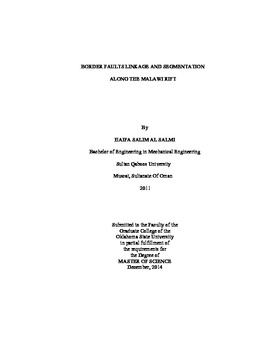| dc.contributor.advisor | Abdel Salam, Mohamed | |
| dc.contributor.author | Al-Salmi, Haifa Salim | |
| dc.date.accessioned | 2016-01-20T15:44:23Z | |
| dc.date.available | 2016-01-20T15:44:23Z | |
| dc.date.issued | 2014-12-01 | |
| dc.identifier.uri | https://hdl.handle.net/11244/25627 | |
| dc.description.abstract | Border fault segmentation characterizes nearly all continental rift zones during their early stage resulting in discrete basins that form the rift system. How border faults form and evolve through time remains a subject of much interest in the study of continental rifts. This study uses Shuttle Radar Topography Mission (SRTM) Digital Elevation Model (DEM) data and previously published seismic sections to investigate the along strike variability in border faults and linkages along the Malawi rift. The availability of SRTM-DEM data allowed detailed examination vertical distance, relationship between basement structures and border fault segments than was previously possible. Detailed topographic profiles were extracted from the SRTM-DEM data at a spacing of 1.4 km along the entire length of the Malawi rift to determine the fault scarp vertical distance. Additionally, seismic cross-sections were used to provide the subsurface structure and displacement of the border faults. The results show the following: (1) Eight border fault segments were identified from the surface data, with segments length varying from ~230 to ~45 km. The general trend observed reveals a decrease in scarp vertical distance from ~2 km in the north to ~0.2 km in the south, confirming the southward propagation and younging of the rift. (2) Unlike the typical cross fault rift model, irregular shaped segments in the Malawi rift show along-strike segmentation by changing from half-graben to full-graben geometry. A half-graben with specific polarity changes to a full-graben geometry before giving place to another half-graben with opposite polarity. (3) Zones of segmentation coincide with pre-existing structures (Permo-Triassic grabens) that strike at high angle to the trend of the rift inhibiting the fault from further propagating. (4) In some cases border faults follow the general structural grain of the basement but deviate from basement structures, striking the later at high angles. (5) Transfers between border fault segments are characterized by conjugate convergent overlap zones. Unlike the commonly held view of rifts compartmentalize by arcuate/sigmoidal shaped border faults alternating in polarity along strike, the results of this study suggest a more complex pattern of border faults and segmentation along the Malawi rift. | |
| dc.format | application/pdf | |
| dc.language | en_US | |
| dc.publisher | Oklahoma State University | |
| dc.rights | Copyright is held by the author who has granted the Oklahoma State University Library the non-exclusive right to share this material in its institutional repository. Contact Digital Library Services at lib-dls@okstate.edu or 405-744-9161 for the permission policy on the use, reproduction or distribution of this material. | |
| dc.title | Border Faults Linkage and Segmentation along the Malawi Rift | |
| dc.type | text | |
| dc.contributor.committeeMember | Atekwana, Estella Akweseh | |
| dc.contributor.committeeMember | Lao-Davila, Daniel Alberto | |
| osu.filename | AlSalmi_okstate_0664M_13644.pdf | |
| osu.accesstype | Open Access | |
| dc.description.department | Geology | |
| dc.type.genre | Thesis | |
